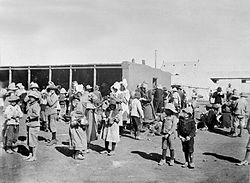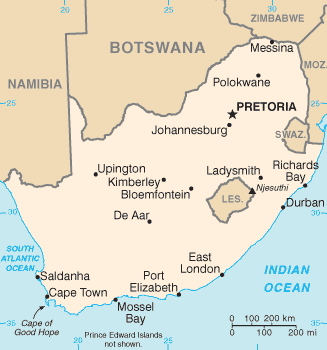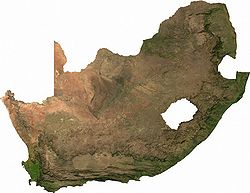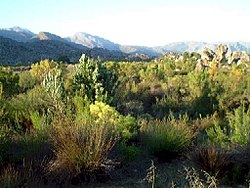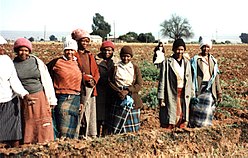South Africa
Template:Featured article Template:Dablink
| Republic of South Africa | |
|---|---|
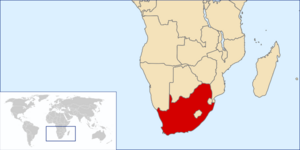
| |
 File:Za-coa.png File:Za-coa.png
| |
| Motto | ǀXam: !ke e: ǀxarra ǁke (English: "Unity In Diversity" or literally, "Diverse People Unite") |
| National anthem | National anthem of South Africa |
| Capital | Cape Town (Legislative) Pretoria (Administrative) Bloemfontein (Judicial) |
| Largest city | Johannesburg |
| Official language | Afrikaans, English, Zulu, Xhosa, Swati, Ndebele, Southern Sotho, Northern Sotho, Tsonga, Tswana, Venda |
| Government type | Parliamentary democracy |
| President | Thabo Mbeki |
| Area | 1,221,037 km² 471,443 mi² (25th) (negligible % water) |
| Population | 47,432,000 (26th) (July 2005 estimate) 44,819,278 (2001 census) |
| Population density | 39/km² (163rd) 101 mi² |
| GDP (PPP) | Total:$570.2 billion (18th) Per capita:$12,161 (55th) (2005 estimate) |
| HDI | 0.658 (medium) (120th) (2003) |
| Currency | Rand (ZAR) |
| Time zone | SAST (UTC+2) Summer:not observed (UTC+2) |
| Country codes | Internet TLD : .za Calling code : +27 |
The Republic of South Africa is a country located at the southern tip of the African continent. It borders the countries of Namibia, Botswana, Zimbabwe, Mozambique, and Swaziland. Lesotho is an enclave entirely surrounded by South African territory.
South Africa has experienced a significantly different evolution from other nations in Africa as a result of two facts. Firstly, immigration from Europe reached levels not experienced in other African communities. Secondly, the strategic importance of the Cape Sea Route, as emphasised by the closure of the Suez Canal during the Six Day War, and mineralogical wealth made the country extremely important to Western interests, particularly during the Cold War. As a result of the former, South Africa is a very racially diverse nation. It has the largest population of people of Coloured (i.e., mixed racial background), White, and Indian communities in Africa. Black South Africans account for slightly less than 80% of the population.
Racial strife between the white minority and the black majority has played a large part in the country's history and politics, culminating in apartheid, which was instituted in 1948 by the National Party, although segregation existed prior to that date. The laws that defined apartheid began to be repealed or abolished by the National Party in 1990 after a long and sometimes violent struggle (including economic sanctions from the international community) by the Black majority as well as many White, Coloured, and Indian South Africans.
The country is one of the few in Africa never to have had a coup d'état, and regular elections have been held for almost a century; however, the vast majority of black South Africans were not enfranchised until 1994. The economy of South Africa is the largest and best developed on the continent, with modern infrastructure common throughout the country.
South Africa is often referred to as The Rainbow Nation - a term coined by Archbishop Desmond Tutu and later elaborated upon by then-President Nelson Mandela as a metaphor to describe the country's newly-developing multicultural diversity in the wake of segregationist apartheid ideology.
South Africa will be the host nation for the 2010 FIFA World Cup. It will be the first time the tournament is held in Africa.
History
South Africa contains some of the oldest archaeological sites in Africa. Extensive fossil remains at the Sterkfontein, Kromdraai and Makapansgat caves suggest that various australopithecines existed in South Africa from about three million years ago. These were succeeded by various species of Homo, including Homo habilis, Homo erectus and modern man, Homo sapiens. Bantu-speaking peoples (the term Bantu is a linguistic term not an ethnic one), iron-using agriculturists and herdsmen, moved south of the Limpopo River into modern-day South Africa by the 4th or 5th century (the Bantu expansion) displacing the original Khoi and San speakers. They slowly moved south and the earliest ironworks in modern-day KwaZulu-Natal Province are believed to date from around 1050. The southernmost group was the Xhosa people, whose language incorporates certain linguistic traits from the earlier Khoi and San people, reaching the Fish River, in today's Eastern Cape Province. These Iron Age populations displaced earlier hunter-gatherer peoples as they migrated.
The written history of South Africa begins with the accounts of European navigators passing South Africa on the East Indies trade routes. Subsequent to the first circumnavigation of the Cape in 1488 by the Portuguese Explorer Bartolomeu Dias a number of shipwrecks occurred along the Southern African coast. Along with the accounts of the early navigators, the accounts of shipwreck survivors provide the earliest written accounts of Southern Africa. In the two centuries following 1488 a number of small fishing settlements were made along the coast by Portuguese sailors, but no written account of these settlements survives. In 1652 a victualling station was established at the Cape of Good Hope by Jan van Riebeeck on behalf of the Dutch East India Company. For most of the 17th and 18th centuries, the slowly expanding settlement was a Dutch possession. The Dutch settlers eventually met the southwesterly expanding Xhosa people in the region of the Fish River. A series of wars, called Cape Frontier Wars, ensued, mainly caused by conflicting land and livestock interests.
To ease Cape labour shortages slaves were brought from Indonesia, Madagascar, and India. Furthermore, troublesome leaders, often of royal descent, were banished from Dutch colonies to South Africa. This group of slaves eventually gave rise to a population that now identifies themselves as "Cape Malays". Cape Malays have traditionally been accorded a higher social status by the European colonists - many became wealthy landowners, but became increasingly dispossessed as Apartheid developed. Cape Malay mosques in District Six were spared, and now serve as monuments for the destruction that occurred around them.
Most of the descendants of these slaves, who often married with Dutch settlers, were later classified together with the remnants of the Khoikhoi as Cape Coloureds. Further intermingling within the Cape Coloured population itself, as well as with Xhosa and other South African people, now means that they constitute roughly 50% of the population in the Western Cape Province.
Great Britain seized the Cape of Good Hope area in 1797 during the Fourth Anglo-Dutch War. The Dutch East India Company declared bankruptcy, and the British annexed the Cape Colony in 1805. The British continued the frontier wars against the AmaXhosa, pushing the eastern frontier eastward through a line of forts established along the Fish River and consolidating it by encouraging British settlement. Due to pressure of abolitionist societies in Britain, the British parliament first stopped its global slave trade in 1806, then abolished slavery in all its colonies in 1833.
The discovery of diamonds in 1867 and gold in 1886 encouraged economic growth and immigration, intensifying the subjugation of the natives. The Boers successfully resisted British encroachments during the First Boer War (1880–1881) using tactics much better suited to local conditions. For example, the Boers wore khaki clothing, which was the same colour as the earth, whereas the British wore bright red uniforms, making them easy targets for Boer sharpshooters. The British returned in greater numbers without their red jackets in the Second Boer War (1899–1902), which was largely opposed by the Liberal Party in the British Parliament. The Boers' attempt to ally themselves with German South West Africa provided the British with yet another excuse to take control of the Boer Republics.
The Boers resisted fiercely, but the British eventually overwhelmed the Boer forces, using their superior numbers and external supply chains and concentration camps as well as the controversial scorched earth tactic. The Treaty of Vereeniging specified full British sovereignty over the South African republics, and the British government agreed to assume the £3,000,000 war debt owed by the Afrikaner governments. One of the main provisions of the treaty ending the war was that 'Blacks' would not be allowed to vote, except in the Cape Colony.
After four years of negotiations, the Union of South Africa was created from the Cape and Natal colonies, as well as the republics of Orange Free State and Transvaal, on May 31, 1910, exactly eight years after the end of the Second Boer War. The newly-created Union of South Africa was a dominion. In 1934 the South African Party and National Party merged to form the United Party, seeking reconciliation between Afrikaners and English-speaking 'Whites', but split in 1939 over the Union's entry into World War II as an ally of the United Kingdom. The right-wing National Party sympathised with Nazi Germany during the war, and sought greater racial segregation, or apartheid, after it.
In 1948, the National Party was elected to power, and began implementing a series of harsh segregationist laws that would become known collectively as apartheid. Not surprisingly, this segregation also applied to the wealth acquired during rapid industrialization of the 1950s, '60s, and '70s. While the White minority enjoyed the highest standard of living in all of Africa, often comparable to "First World" western nations, the Black majority remained disadvantaged by almost every standard, including income, education, housing, and life expectancy. However, the average income and life expectancy of a black, 'Indian' or 'colored' South African compared favorably to many other African states, such as Ghana and Tanzania.
Apartheid became increasingly controversial, leading to widespread sanctions and divestment abroad and growing unrest and oppression within South Africa. (See also special section on History of South Africa in the apartheid era.) A long period of harsh suppression by the government, and resistance, strikes, marches, protests, and sabotage, by various anti-apartheid movements, most notably the African National Congress (ANC), followed. In 1990 the National Party government took the first step towards negotiating itself out of power when it lifted the ban on the African National Congress and other left-wing political organisations, and released Nelson Mandela from prison after 27 years. Apartheid legislation was gradually removed from the statute books, and the first multi-racial elections were held in 1994. The ANC won by an overwhelming majority, and has been in power ever since.
Despite the end of apartheid, millions of South Africans, mostly black, continue to live in poverty. This is attributed to the legacy of the apartheid regime and, increasingly, what many see as the failure of the current government to tackle social issues, coupled with the monetary and fiscal discipline of the current government to ensure both redistribution of wealth and economic growth. However, the ANC's social housing policy has produced some improvement in living conditions in many areas by redirecting fiscal spending and improving the efficiency of the tax collection system.
Politics
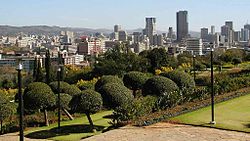
Template:Morepolitics South Africa has a bicameral Parliament: the National Council of Provinces (or upper house) with 90 members, and a National Assembly (or lower house) with 400 members. Members of the lower house are elected on a population basis by proportional representation: half of the members are elected from national lists and half are elected from provincial lists. Ten members are elected to represent each province in the National Council of Provinces, regardless of the population of the province. Elections for both chambers are held every five years. The government is formed in the lower house, and the leader of the majority party in the National Assembly is the President.
Current South African politics is dominated by the African National Congress (ANC), which received 69.7% of the vote during the last 2004 general election and 66.3% of the vote in the 2006 municipal election. The main challenger to the ANC's rule is the Democratic Alliance party, which received 12.4% of the vote in the 2004 election and 14.8% in the 2006 election. The leader of this party is Tony Leon. The formerly dominant New National Party, which introduced apartheid through its predecessor, the National Party, has suffered increasing humiliation at election polls since 1994, and finally voted to disband. It chose to merge with the ANC on 9 April 2005. Other major political parties represented in Parliament are the Inkatha Freedom Party, which mainly represents Zulu voters, and the Independent Democrats, who took 6.97% and 1.7% of the vote respectively in the 2004 election.
Administrative divisions
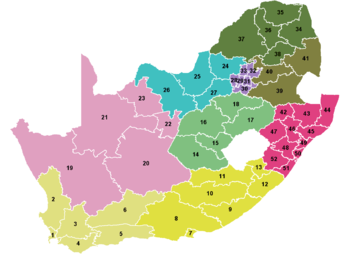
When apartheid ended in 1994, the South African government had to integrate the formerly independent and semi-independent Bantustans into the political structure of South Africa. To this end, it abolished the four former provinces of South Africa (Cape Province, Natal, Orange Free State, and Transvaal) and replaced them with nine fully integrated provinces. The new provinces are usually much smaller than the former provinces, which theoretically is in order to give local governments more resources to distribute over smaller areas.
The nine provinces are further sub-divided into 52 districts, six of which are metropolitan and 46 district municipalities. The 46 district municipalities are further subdivided into 231 local municipalities. The district municipalities also contain 20 district management areas (mostly game parks) which are directly governed by the district municipalities. The six metropolitan municipalities perform the functions of both district and local municipalities.The new provinces are: Template:SouthAfricaProvinces
Geography
South Africa is located at the extreme south of Africa, with a long coastline that stretches more than 2,500 kilometres (1,550 mi) and across two oceans (the Atlantic and the Indian). At 470,979 mi² (1,219,912 km²[1]), South Africa is the world's 25th-largest country (after Mali). It is comparable in size to Colombia, and is nearly twice the size of the US state of Texas.
South Africa has a great variety of climate zones, from the extreme desert of the Kalahari near Namibia to lush subtropical climate along the border with Mozambique. It quickly rises over a mountainous escarpment towards the interior plateau known as the Highveld. Even though South Africa is classified as semi-arid, there is considerable variation in climate as well as topography.
The interior of South Africa is a giant, mountainous, and sparsely populated scrubland Karoo plateau, which is drier towards the northwest along the Kalahari desert. In contrast, the eastern coastline is lush and well-watered, which produces a climate similar to the tropics. The extreme southwest has a climate remarkably similar to that of the Mediterranean with wet winters and hot, dry summers. This area also produces much of South Africa's wine. This region is also particularly known for its wind, which blows intermittently almost all year. The severity of this wind made passing around the Cape of Good Hope particularly treacherous for sailors, causing many shipwrecks. Further east on the country's south coast, rainfall is distributed more evenly throughout the year, producing a green landscape. This area is popularly known as the Garden Route.
The Free State is particularly flat due to the fact that the eastern region of the Highveld does not extend as far north as the western region. North of the Vaal River, the Highveld becomes better watered and does not experience subtropical extremes of heat. Johannesburg, in the centre of the Highveld, is at 1,740 metres (5,709 ft) and receives an annual rainfall of 760 millimetres (30 in). Winters in this region are cold, although snow is rare.
To the north and east of Johannesburg, the altitude drops beyond the Highveld's escarpment, and turns into the Lowveld. The Lowveld has particularly high temperatures, and is also the location of traditional South African Bushveld. The high Drakensberg mountains, which form the eastern escarpment of the Highveld, offer limited skiing opportunities in winter. Many people think that the coldest place in South Africa is Sutherland in the western Roggeveld Mountains, where midwinter temperatures can reach as low as –15 degrees Celsius (5 °F). In fact, the coldest place is actually Buffelsfontein, which is in the Molteno district of the Eastern Cape. Buffelsfontein recorded a low of –18.6 degrees Celsius. The deep interior has the hottest temperatures: A temperature of 51.7 °C (125 °F) was recorded in 1948 in the Northern Cape Kalahari near Upington.[1]
South Africa also has one possession, the small sub-antarctic archipelago of the Prince Edward Islands, consisting of Marion Island (290 km²/112 mi²) and Prince Edward Island (45 km²/17.3 mi²) (not to be confused with the Canadian province of the same name).
Flora and fauna
South Africa has more than 20,000 different plants, or about 10% of all the known species of plants on Earth, making it particularly rich in plant biodiversity.
South Africa's most prevalent biome is grassland, particularly on the Highveld, where the plant cover is dominated by different grasses, low shrubs, and acacia trees, mainly camel-thorn and whitethorn. Vegetation becomes even more sparse towards the northwest due to low rainfall. There are several species of water-storing succulents like aloes and euphorbias in the very hot and dry Namaqualand area. The grass and thorn savannah turns slowly into a bush savannah towards the northeast of the country, with more dense growth. There are significant numbers of baobab trees in this area, near the northern end of Kruger National Park.[2]
The Fynbos Biome, one of the six floral kingdoms, is located in a small region of the Western Cape and contains more than 9,000 of those species, making it among the richest regions on earth in terms of floral biodiversity. The majority of the plants are evergreen hard-leaf plants with fine, needle-like leaves, such as the sclerophyllous plants. Another uniquely South African plant is the protea genus of flowering plants. There are around 130 different species of protea in South Africa.
While South Africa has a great wealth of flowering plants, it has few forests. Only 1% of South Africa is forest, almost exclusively in the humid coastal plain along the Indian Ocean in KwaZulu-Natal. There are even smaller reserves of forests that are out of the reach of fire, known as montane forests. Plantations of imported tree species are predominant, particularly the non-native eucalyptus and pine. South Africa has lost extensive acreage of natural habitat in the last four decades, primarily due to overpopulation and sprawling development patterns. South Africa is one of the worst affected countries in the world when it comes to invasion by alien species with many e.g. Black Wattle, Port Jackson, Hakea, Lantana and Jacaranda posing a significant threat to the native biodiversity and the already scarce water resources. The original temperate forest that met the first European settlers to South Africa was exploited ruthlessly until only small patches remained. Currently, South African hardwood trees like Real Yellowwood (Podocarpus latifolius), stinkwood (Ocotea bullata), and South African Black Ironwood (Olea laurifolia) are under government protection.
Numerous mammals are found in the bushveld habitats including lion, leopard, White Rhino, Blue Wildebeest, kudu, impala and giraffe. There is a significant extent of the bushveld habitat in the northeast including Kruger National Park and the Mala Mala Reserve, as well as in the far north in the Waterberg Biosphere.
Economy
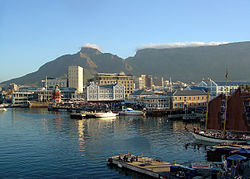
By UN classification South Africa is a middle-income country with an abundant supply of resources, well-developed financial, legal, communications, energy, and transport sectors, a stock exchange (the JSE Securities Exchange), that ranks among the 10 largest in the world, and a modern infrastructure supporting an efficient distribution of goods to major urban centres throughout the region. South Africa's per capita GDP, corrected for purchasing power parity, positions the country as one of the 50 wealthiest in the world. In many respects, South Africa is developed; however, this development is significantly localised around 4 areas, namely: Cape Town, Port Elizabeth, Durban, and Pretoria-Johannesburg. Beyond these 4 economic centres, development is marginal and poverty still reigns despite Government strategies. However, key marginal areas are experiencing rapid growth recently. Such areas include: Mossel Bay to Plettenberg Bay; Rustenburg area; Nelspruit area; Bloemfontein; Cape West Coast; KZN North Coast amongst others. Large income gaps and a dual economy designate South Africa as developing; South Africa has one of the highest rates of income inequality in the world. Consecutive growth rates in the last ten years are helping lower unemployment; however, the economy still has a way to go, and daunting economic problems remain. Other problems are crime, corruption, and HIV/AIDS. At the start of 2000, President Thabo Mbeki vowed to promote economic growth and foreign investment by relaxing restrictive labour laws, stepping up the pace of privatisation, and cutting unneeded governmental spending. His policies face strong opposition from organised labour. It is estimated that South Africa accounts for up to 30% of the gross domestic product of the entire African continent. South Africa is also the continent's largest energy producer and consumer.
The Rand, the world's most actively traded emerging market currency, has joined an elite club of 15 currencies - the Continuous linked settlement (CLS) - where forex transactions are settled immediately, lowering the risks of transacting across time zones. The South African Rand (ZAR) was the best performing currency against the US Dollar between 2002 and 2005, according to the Bloomberg Currency Scorecard. The volatility of the Rand has affected economic activity, with the rand falling sharply during 2001, hitting an historic low of R13.85 to the United States dollar, raising fears of inflation, and causing the Reserve Bank to increase interest rates. The rand has since recovered, trading at R5.99 to the dollar as of January 2006 while the South African Reserve Bank's policy of inflation targeting has brought inflation under control. The stronger Rand has however put exporters under considerable pressure, with many calling for government to intervene in the exchange rate to help soften the rand, and many others dismissing staff.
21.5% of the adult South African population have been estimated to be HIV positive in 2003.[3] The government has recently, after much delay, devoted substantial resources to fighting the epidemic. A recent study from the African Journal of AIDS Research by Thomas Rehle and Olive Shisana showed the infection rate starting to level off, from 4.2% to 1.7% infection rate for 15-49 year olds, and AIDS deaths peaking at 487,320 in 2008.
In 2000 President Mbeki publicly questioned the importance of HIV in causing AIDS, controversially suggesting that the main cause was "poverty".[4] In 2001 the government appointed a panel of scientists, including a number of AIDS dissidents (who question the mainstream view on HIV), to report back on the issue. Following their report, the government stated that it continues to base its policy on the premise that the cause of AIDS is indeed HIV.[5] The controversy has not abated, and organisations such as the Treatment Action Campaign continue to mount political and legal challenges to what they claim is the government's slow response to the epidemic.
Refugees from poorer neighbouring countries abound with immigrants from the DRC, Mozambique, Zimbabwe, Malawi and many others representing a large portion of the informal sector. With high unemployment levels amongst poorer South Africans, xenophobia is a very real fear and many people born in South Africa feel resentful of immigrants who are seen to be depriving the native population of jobs, a feeling which has been given credibility by the fact that many South African employers have employed migrants from other countries for lower pay than South African citizens, especially in the construction, tourism, agriculture and domestic service industries. Illegal immigrants are also heavily involved in informal trading.[6] However, many immigrants to South Africa continue to live in poor conditions, and the South African immigration policy has become increasingly restrictive since 1994.[7]
Agriculture
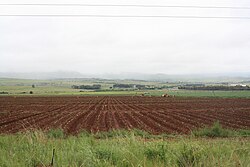
South Africa has a large agricultural sector, and is a net exporter of farming products. There are almost a thousand agricultural cooperatives and agribusinesses throughout the country, and agricultural exports have constituted 8% of South Africa's total exports for the past five years. The agricultural industry contributes around 10% of formal employment, relatively low compared to other parts of Africa, as well as providing work for casual labourers and contributing around 2.6% of GDP for the nation.[8] However, due to the aridity of the land, only 13.5% can be used for crop production, and only 3% is considered high potential land.[9]
Although the commercial farming sector is relatively well developed, people in some rural areas still survive on subsistence farming. It is the eighth largest wine producer in the world, and the eleventh largest producer of sunflower seed. South Africa is a net exporter of agricultural products and foodstuffs, the largest number of exported items being sugar, grapes, citrus, nectarines, wine and deciduous fruit. The largest locally produced crop is maize(corn), and it has been estimated that 9 million tons are produced every year, with 7.4 million tons being consumed. Livestock are also popular on South African farms, with the country producing 85% of all meat consumed. The dairy industry consists of around 4,300 milk producers providing employment for 60,000 farm workers and contributing to the livelihoods of around 40,000 others.[10]
In recent years, the agricultural sector has introduced several reforms, some of which are controversial, such as land reform and the deregulation of the market for agricultural products. Land reform has been criticised both by farmers' groups and by landless workers, the latter alleging that the pace of change has not been fast enough, and the former alleging racist treatment and expressing concerns that a similar situation to Robert Mugabe's land reform policy may develop [11], a fear exacerbated by comments made by the country's deputy president.[12][13] The sector continues to face problems with increased foreign competition and crime being two of the major challenges for the industry.
Crime against the farming community continues to be a problem. The rural farm population has shouldered a great increase in attacks and harassment and has suffered as many as 2000 farm murders since 1994, and this has caused many commercial farmers to flee the countryside for the protection of the gated communities of the cities and that offered by other nations. The government has been accused of not devoting enough time and money to tackle the problem as opposed to other forms of violent crime, or simply inefficiency and incompetence.[14]
Another issue which affects South African agriculture is environmental damage caused by misuse of the land and global climate change. South Africa is unusually vulnerable to climate change and resultant diminution of surface waters. Some predictions shows surface water supply could decrease by 60 percent by the year 2070 in parts of the Western Cape.[15] To reverse the damage caused by land mismanagement, the government has supported a scheme which promotes sustainable development and the use of natural resources.[16]
Demographics
South Africa is a nation of over 47 million people of diverse origins, cultures, languages, and beliefs. The 2005 Statistics South Africa census provided five racial categories by which people could classify themselves, the last of which, "unspecified/other" drew negligible responses, and these results were omitted.[17] Results for the other categories were Black African at 79.4%, White at 9.3%, Coloured at 8.8%, and Indian or Asian at 2.5%.
By far the major part of the population classified itself as African or black, but it is not culturally or linguistically homogenous. Major ethnic groups include the Zulu, Xhosa, Basotho (South Sotho), Bapedi (North Sotho), Venda, Tswana, Tsonga, Swazi and Ndebele. Some, such as the Zulu, Xhosa, Bapedi and Venda groups, are unique to South Africa.
Other groups are distributed across the borders with South Africa's neighbours: The Basotho group is also the major ethnic group in Lesotho. The Tswana ethnic group constitute the majority of the population of Botswana. The Swazi ethnic group is the major ethnic group in Swaziland. The Ndebele ethnic group is also found in Matabeleland in Zimbabwe, where they are known as the Matabele. These Ndebele people are however in effect Zulu people because the language they speak is Zulu and they are the descendants of the Warrior Mzilikazi who escaped persecution from Shaka to settle in that part of the World. The Tsonga ethnic group is also found in southern Mozambique, where they are known as the Shangaan.
The white population descends largely from colonial immigrants: Dutch, German, French Huguenot, and British. Culturally and linguistically, they are divided into the Afrikaners, who speak Afrikaans, and English-speaking groups, many of whom originated from British immigrants (see Anglo African). Many small communities immigrating over the last century retain the use of other languages. The white population is on the decrease due to a low birth rate and emigration; as a factor in their decision to emigrate, many cite the high crime rate and the government's affirmative action policies.
The term "Coloured" is still largely used for the people of mixed race descended from slaves brought in from East and Central Africa, the indigenous Khoisan who lived in the Cape at the time, indigenous African Blacks, Whites (mostly the Dutch/Afrikaner and British settlers) as well as an admixture of Javanese, Malay, Indian, Malagasy and other European (such as Portuguese) and Asian blood (such as Burmese). The majority speak Afrikaans. Khoisan is a term used to describe two separate groups, physically similar in that they were light-skinned and small in stature. The Khoikhoi, who were called Hottentots by the Europeans, were pastoralists and were effectively annihilated; the San, called Bushmen by the Europeans, were hunter-gatherers. Within what is known as the Coloured community, you will also find some more recent immigrants - Coloureds from the old Rhodesia (now Zimbabwe) and Namibia, as well as immigrants of mixed descent from India and Burma (Anglo-Indians/Anglo-Burmese) who were welcomed to the Cape when India and Burma received their Independence.
The major part of the Asian population of the country is Indian in origin, many of them descended from indentured workers brought in the 19th century to work on the sugar plantations of the eastern coastal area then known as Natal. There is also a significant group of Chinese South Africans (approximately 100 000 individuals).
Culture
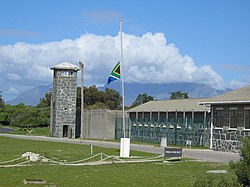
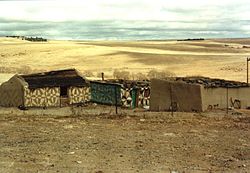
It may be argued that there is no "single" culture in South Africa because of its ethnic diversity. Today, the diversity in foods from many cultures is enjoyed by all and especially marketed to tourists who wish to sample the large variety of South African cuisine. In addition to food, music and dance feature prominently.
South African cuisine is heavily meat-based and has spawned the distinctively South African social gathering known as a braai. South Africa has also developed into a major wine producer, with some of the best vineyards in the world lying in valleys around Stellenbosch, Franschoek, Paarl and Barrydale.
There is great diversity in music from South Africa. Many black musicians who sang in Afrikaans or English during apartheid have since begun to sing in traditional African languages, and have developed a unique style called Kwaito. Of note is Brenda Fassie, who launched to fame with her song "Weekend Special", which was sung in English. More famous traditional musicians include Ladysmith Black Mambazo, while the Soweto String Quartet performs classic music with an African flavour. White and Coloured South African singers tend to avoid traditional African musical themes, instead preferring more European musical styles including such western metal bands such as Seether. Afrikaans music covers multiple genres, such as the contemporary Steve Hofmeyr and the punk rock band Fokofpolisiekar.
The country's black majority still has a substantial number of rural inhabitants who lead largely impoverished lives. It is among these people, however, that traditional dance and music survive; as blacks have become increasingly urbanised and westernised, aspects of traditional culture have declined. Urban blacks usually speak English or Afrikaans in addition to their native tongue. There are smaller but still significant groups of speakers of Khoisan languages which are not official languages, but are one of the eight officially recognised languages. There are small groups of speakers of endangered languages, most of which are from the Khoi-San family, that receive no official status; however, some groups within South Africa are attempting to promote their use and revival.
The white minority lead lifestyles similar in many respects to whites found in Western Europe, North America and Australasia.
Despite considerable discrimination under apartheid, Coloureds tend to relate more to white South African culture rather than black South African culture, especially Afrikaans-speaking Coloured people whose language and religious beliefs are similar or identical to white Afrikaners.
Asians, predominantly of Indian origin, preserve their own cultural heritage, languages and religious beliefs, being either Hindu or Sunni Muslim, and speaking English, with Indian languages like Tamil or Gujarati being spoken less frequently. Most Indians arrived on the famous Truro ship as indentured labourers in Natal to work the Sugar Cane Fields. There is a much smaller Chinese community in South Africa, although its numbers have increased due to immigration from Taiwan. Since the Taiwanese were classified as White, rather than Asian, under apartheid, they tend to be more culturally similar to whites in many ways than they are to other Asians.
Languages
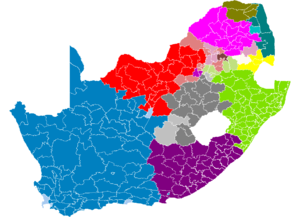
South Africa has 11 official languages: Afrikaans, English, Ndebele, Northern Sotho, Southern Sotho, Swati, Tsonga, Tswana, Venda, Xhosa and Zulu. In this regard it is second only to India in number. While each language is technically equal to every other, English has emerged recently as the chief-among-peers as it is the most widely spoken language across racial barriers as well as globally, even though it is not the most widely spoken language by population. There are 11 official names for South Africa, one for each of the official national languages.
The country also recognises eight non-official languages: Fanagalo, Khoe, Lobedu, Nama, Northern Ndebele, Phuthi, San and South African Sign Language. These non-official languages may be used in certain official uses in limited areas where it has been determined that these languages are prevalent. Nevertheless, their populations are not such that they require nationwide recognition.
Many of the "unofficial languages" of the San and Khoikhoi people contain regional dialects stretching northward into Namibia and Botswana, and elsewhere. These people, who are a physically distinct population from other Africans, have their own cultural identity based on their hunter-gatherer societies. They have been marginalised to a great extent, and many of their languages are in danger of becoming extinct.
Many white South Africans also speak other European languages, such as Portuguese (also spoken by Angolan and Mozambican blacks), German, and Greek, while many Asians and Indians in South Africa speak South Asian languages, such as Hindi, Gujarati and Tamil.
Crime
Crime has been a major problem in South Africa. According to a survey for the period 1998 - 2000 compiled by the United Nations, South Africa was ranked second for assault and murder (by all means) per capita.[18] Total crime per capita is 10th out of the 60 countries in the data set. Nevertheless, crime has had a pronounced effect on society: many wealthier South Africans moved into gated communities, abandoning the central business districts of some cities for the relative security of suburbs. This effect is most pronounced in Johannesburg, although the trend is noticeable in other cities as well. Many emigrants from South Africa also state that crime was a big motivator for them to leave. Crime against the farming community has continued to be a major problem in the country.
Military
South Africa's armed forces, known as the South African National Defence Force (SANDF), was created in 1994. Previously known simply as the South African Defence Force (SADF), the new force consists of the forces of the old SADF, as well as the military forces of the organisations fighting for liberation, namely Umkhonto we Sizwe (MK), Azanian People's Liberation Army (APLA), and the former homeland defence forces. The SANDF is subdivided into four branches, the South African Army, the South African Air Force, the South African Navy, and the South African Military Health Services.
In recent years, the SANDF has become a major peacekeeping force in Africa, and has been involved in operations in Lesotho, the Democratic Republic of the Congo, and Burundi, amongst others. It has also participated as a part of multi-national UN peacekeeping forces.
South Africa undertook a nuclear weapons program in the 70s and may have conducted a nuclear test over the Atlantic in 1979, but has since renounced its nuclear program and signed the Nuclear Non-Proliferation Treaty in 1991 after destroying its small nuclear arsenal. It is the only African country to have successfully developed nuclear weapons, and to date is the only country in the world to have voluntarily dismantled its entire nuclear weapons arsenal.
Media
South Africa has a large, free, and active press that regularly challenges the government, a habit formed during the apartheid era when the press was the medium least controlled by the government. Major scandals have erupted when the press reported charges of corruption that were proven to be true in cases such as that of Schabir Shaik, in which (then) deputy president Jacob Zuma was implicated, and the corruption allegations that led to the dismissal of Winnie Mandela from parliament. The government's stance on the 2005 Zimbabwe parliamentary elections and AIDS have also attracted plenty of coverage.
Even though South Africa now has the most sophisticated media network in Africa, it was one of the last countries in the world to allow television, with colour TV broadcasts commencing in 1975. By the end of apartheid in 1994, television networks covered all urban areas and some less populated areas, while radio networks covered almost all of the country.
During the Apartheid era the majority of commercial and all public-service radio stations and all of the television channels were operated by the South African Broadcasting Corporation (SABC), and were subject to strict control and censorship by the government, with a few independent regional stations allowed. The creation of the independent black homelands (or Bantustans) in the 1970s allowed for the establishment of TV and radio stations outside of the control of the apartheid Government. Following the demise of apartheid, the broadcasting industry was de-regulated with many of the commercial regional SABC radio stations and former Bantustan stations privatised and sold to companies and consortiums that were majority owned by black people. Three SABC television channels are in place at present.
An African language channel was introduced to the SABC in 1981 (during apartheid) with a second African language channel added later in the decade. The SABC's television monopoly was eventually challenged in 1986 when a new privately owned subscription television network, M-Net, was launched. M-Net was forbidden to operate a news service.
South Africa currently has two terrestrial free-to-air television networks (SABC and e.tv), one subscription based terrestrial network (M-Net), as well as has access to satellite television (DStv) which is operated by M-Net's owners, Multichoice. e.tv is allowed to operate an independent television news service. The SABC broadcasts news and entertainment channels Africa-wide via satellite.
See also
International rankings
References
- ↑ SouthAfrica.info: South Africa's geography
- ↑ South Africa Online Travel Guide: Plants and Vegetation in South Africa
- ↑ CIA World Factbook, "South Africa"
- ↑ BBC News: Controversy dogs Aids forum
- ↑ BBC News: South African split over Aids
- ↑ African Security Review Vol 5 No 4, 1996: Strategic Perspectives on Illegal Immigration into South Africa
- ↑ Queens College: The Brain Gain: Skilled Migrants and Immigration Policy in Post-Apartheid South Africa
- ↑ Human Rights Watch, 2001. Unequal Protection: The State Response to Violent Crime on South African Farms ISBN 1-56432-263-7 http://www.hrw.org/reports/2001/safrica2/
- ↑ Mohamed, Najma. 2000. Greening Land and Agrarian Reform: A Case for Sustainable Agriculture. In At the Crossroads: Land and Agrarian Reform in South Africa into the 21st Century. Ed. Cousins, Ben. Bellville, School of Government, University of the Western Cape. ISBN 1-86808-467-1
- ↑ South Africa Online: Agriculture. Retrieved on 2006-07-17.
- ↑ South Africa's bitter harvest
- ↑ BBC News: South Africans' long wait for land
- ↑ BBC News: SA 'to learn from' land seizures
- ↑ The Sunday Times Magazine: Farms of Fear
- ↑ Reuters Alertnet: "Climate change to create African 'water refugees' - scientists", accessed Sept 21 2006
- ↑ Department of Agriculture South Africa
- ↑ Statistics South Africa: Census 2001
- ↑ NationMaster: South African Crime Statistics
- A History of South Africa, Third Edition. Leonard Thompson. Yale University Press. 1 March 2001. 384 pages. ISBN 0-300-08776-4.
- South Africa: A Narrative History. Frank Welsh. Kodansha America. 1 February 1999. 606 pages. ISBN 1-56836-258-7.
- The Atlas of Changing South Africa. A. J. Christopher. 1 October 2000. 216 pages. ISBN 0-415-21178-6.
- The Politics of the New South Africa. Heather Deegan. 28 December 2000. 256 pages. ISBN 0-582-38227-0.
- Times Online[2]. April 2 2006.
- Making of Modern South Africa: Conquest, Segregation and Apartheid. Nigel Worden. 1 July 2000. 194 pages. ISBN 0-631-21661-8.
- Emerging Johannesburg: Perspectives on the Postapartheid City. Richard Tomlinson, et al. 1 January 2003. 336 pages. ISBN 0-415-93559-8.
- "Religion and Politics in South Africa." David Hein. Modern Age 31 (1987): 21-30.
- South Africa Government Online. Accessed 20 February 2005.
- SouthAfrica.info. Accessed 12 February 2005.
- South Africa war graves project
External links
Template:Portal Template:Sisterlinks
Government
- South Africa Government Online official government site
- Parliament of South Africa official site
- Statistics South Africa official government site
- South Africa's Official Gateway
- South African Police Services
News
- Business Day financial daily
- Independent Online
- Mail & Guardian daily newspaper
- News 24
- South African Weather Service
Music, Theatre, Entertainment & Arts
- SA Music, Entertainment & Arts South African Music, Theatre, Entertainment & Arts portal
Overviews
- The Economist/Country Briefings - South Africa
- South Africa's location on a 3D globe (Java)
- BBC News Country Profile - South Africa
- Encyclopaedia Britannica, South Africa - Country Page
- CIA World Factbook - South Africa
- Library of Congress Country Study - South Africa data as of November 1994
- Open Directory Project - South Africa directory category
- Diamond Mines of South Africa, includes anthropological, ethnographic and historic description of South Africa Former De Beers general Manager 800-page overview of the history of South Africa and its diamond mines.
Tourism
- Template:Wikitravel
- Welcome to South Africa official South African tourism site
- Maps of South Africa
Languages
Template:Africa Template:Peri-Antarctic countries and overseas territories
af:Suid-Afrika am:ደቡብ አፍሪካ ang:Sūðafrica ar:جنوب أفريقيا an:Surafrica frp:Africa du Sud ast:República Surafricana zh-min-nan:Lâm-hui-kok be:Паўднёва-Афрыканская Рэспубліка bs:Južnoafrička Republika br:Suafrika bg:Южноафриканска република ca:Sud-àfrica cs:Jihoafrická republika cy:De Affrica da:Sydafrika de:Südafrika et:Lõuna-Aafrika Vabariik el:Νότια Αφρική es:Sudáfrica eo:Sud-Afriko fa:افریقای جنوبی fr:Afrique du Sud ga:An Afraic Theas gd:Afraga a Deas gl:Sudáfrica - Ningizimu Afrika ko:남아프리카 공화국 hi:दक्षिण अफ्रीका hr:Južnoafrička Republika io:Sud-Afrika id:Afrika Selatan ia:Africa del Sud xh:UMzantsi Afrika zu:IRiphabliki yaseNingizimu Afrika is:Suður-Afríka it:Sudafrica he:דרום אפריקה ka:სამხრეთ აფრიკის რესპუბლიკა ks:दक्षिण अफ्रीका kw:Afrika Dheghow ht:Afrik disid (peyi) ku:Efrîqaya Başûr la:Africa Australis lv:Dienvidāfrikas Republika lb:Südafrika lt:Pietų Afrikos Respublika li:Zuud-Afrika hu:Dél-afrikai Köztársaság mk:Јужна Африка mi:Awherika ki te Tonga ms:Afrika Selatan nl:Zuid-Afrika nds-nl:Zuud-Afrika ja:南アフリカ共和国 no:Sør-Afrika nn:Sør-Afrika oc:Africa del Sud ug:جەنۇبىي ئافرىقا pam:South Africa nds:Süüdafrika pl:Republika Południowej Afryki pt:África do Sul ro:Africa de Sud rm:Africa dal Sid ru:Южно-Африканская Республика sa:दक्षिण अफ्रीका tn:Aferika Borwa sq:Afrika e Jugut scn:Àfrica dû Sud simple:South Africa sk:Južná Afrika (štát) sl:Južna Afrika sr:Јужноафричка Република sh:Južna Afrika fi:Etelä-Afrikka sv:Sydafrika tl:Timog Aprika ta:தென்னாபிரிக்கா th:ประเทศแอฟริกาใต้ vi:Cộng hòa Nam Phi tg:Африқои Ҷанубӣ tpi:Saut Aprika tr:Güney Afrika Cumhuriyeti uk:Південно-Африканська Республіка zh:南非
